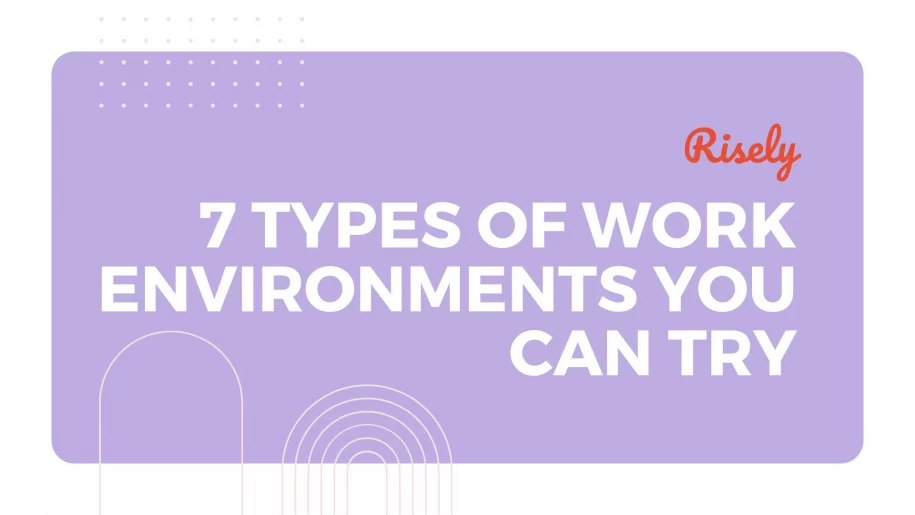7 Types Of Work Environments You Can Try
In today’s work culture, various types of work environments exist to cater to different philosophies, needs, and job functions. Each type offers its unique benefits and challenges. In this blog, we will explore seven types of work environments with real-life examples and discuss their impact on employee satisfaction and organizational success.What makes up a work environment?
A work environment shapes employee satisfaction, productivity, and overall job experience. It encompasses the physical aspects of the workplace, such as office layout and equipment, as well as intangible elements like company culture and employee relationships. A positive work environment not only attracts and retains talented employees but also fosters innovation, collaboration, and employee engagement. On the other hand, a negative environment can lead to disengagement, decreased productivity, and high turnover rates.7 Types of work environments and how do they impact your team?
By understanding the different types of work environments and their characteristics, you can create an environment that meets the diverse needs of employees and promotes a positive workplace culture. This, in turn, enhances employee productivity, job satisfaction, and overall organizational success.The Traditional Office Environment
The traditional office environment is the most common type of work environment. It is a conventional work setting with a structured office layout and individual workstations for employees. This type of environment promotes a sense of professionalism and hierarchy within the organization. In a traditional office environment, you typically work fixed hours, usually from 9 to 5, and are expected to be present in the office physically. You have designated workspaces where you can focus on tasks and responsibilities. This environment fosters a sense of routine and stability. However, the traditional office environment could lack flexibility and hinder employee autonomy. Think of sticking to the strict office layout and limited collaboration spaces. It can limit creativity and hinder open communication among team members. While this environment may work well for some roles that require individual work and focus, it might not be suitable for all your employees, especially those who thrive in more dynamic and collaborative settings.The Remote Work Environment
The remote work has gained significant popularity, especially in recent years. This type of work environment allows you to work from a location outside the traditional office, such as homes, co-working spaces, or anywhere with an internet connection. It will enable you to achieve a better work-life balance and eliminate the time and stress associated with commuting. Remote work options also allow you to attract and retain talent from a broader geographical area, as location is no longer a job constraint. However, remote work is not without challenges. Communication and collaboration can become more difficult in a remote work setting, as there is less face-to-face interaction. Some teams experience feelings of isolation and reduced connection with their colleagues. If you are exploring this option, implement effective communication tools and strategies to overcome these challenges and maintain a sense of team cohesion.The Hybrid Work Environment
The hybrid work environment combines elements of both the traditional office environment and the remote work set-up. It allows you to split between working in a physical workplace and remotely. In a hybrid environment, you can choose where they work based on their preferences and job requirements. It allows for a better work-life balance and increased autonomy. You also get opportunities for in-person collaboration and social interactions while still allowing for the benefits of remote work. Managing a hybrid work environment can be challenging for employers. It requires you to focus on effective communication, clear guidelines, and trust between managers and employees. Office politics can also arise, with potential disparities between in-office and remote employees. You must establish and consistently communicate fair and inclusive policies to ensure a positive hybrid environment.The Flexible Work Environment
The flexible work setting focuses on adapting to employees’ individual needs, allowing them to adjust their work schedules and arrangements based on personal commitments and preferences. This type of work environment recognizes that productivity and job satisfaction can be achieved outside of the traditional 9-to-5 structure. In a flexible work environment, employees are free to choose when and where they work as long as they meet their job responsibilities and deadlines. For instance, AirBnB took note of the need and changed their way of work around the COVID pandemic. It can include flexible work hours, compressed workweeks, part-time work, or job-sharing arrangements. Plus, you can provide ergonomic furniture and equipment to support employee well-being and comfort. The flexible work environment promotes work-life balance and accommodates the diverse needs of employees. It allows your team to better manage personal commitments, such as childcare or pursuing additional education. This flexibility can lead to increased job satisfaction, employee engagement, and retention. But, ensure that you are not deviating from your objectives.The Collaborative Work Environment
The collaborative work emphasizes teamwork, shared goals, and open communication among employees. It provides spaces and opportunities for collaboration, idea-sharing, and problem-solving. In a collaborative environment, you are encouraged to work with others, exchange ideas, and leverage each other’s strengths and expertise. You can do this in collaborative spaces, such as open-plan offices, breakout areas, or designated collaboration zones. If you want to pursue this path, you need effective communication channels and a culture of trust. A collaborative work environment benefits from diverse perspectives and promotes a sense of unity and collective success. It encourages employee engagement, creativity, and innovation. Team members can learn from each other, support one another, and develop stronger working relationships.The Competitive Work Environment
Focusing on achievement, performance, and individual and team goals characterizes the competitive work environment. It encourages you to strive for excellence and rewards those who meet or exceed expectations. In a competitive environment, you are motivated by recognition, rewards, and opportunities for career development. As the leader, you set clear performance metrics and provide meaningful feedback to drive improvement and growth, along with incentives or bonuses tied to individual or team performance. The competitive work environment fosters a sense of motivation, ambition, and healthy competition among employees. It can drive innovation, productivity, and continuous improvement. However, you need to strike a balance and ensure that the competitive environment does not become toxic or discourage collaboration and teamwork.The Creative Work Environment
The creative work environment is designed to foster creativity, innovation, and the generation of new ideas. Google’s workplaces are a great example – with their mix of cafes, open desks, and recreational areas interspersed among employees. It provides you with the space and culture that encourages employees to think outside the box and explore novel approaches to problem-solving. In a creative environment, you can experiment, take risks, and challenge conventional thinking. It may include flexible workspaces, informal meeting areas, and cultural elements that inspire creativity, such as art displays or music. The creative work environment values diversity of thought and encourages employees to share their unique perspectives and experiences. It promotes collaboration, open communication, and psychological safety, where employees feel comfortable sharing their ideas and taking creative risks.How can you develop effective work environments?
Developing effective work environments involves understanding the needs and preferences of your team members and implementing strategies to foster a positive work culture and employee engagement. Your ultimate goal is to create an environment that accommodates the diverse needs of employees while aligning with the organization’s goals and values. Understanding each team member’s unique needs and preferences is crucial for creating an environment that promotes productivity, job satisfaction, and overall well-being. You need to focus on open communication, regular feedback, and individualized support. Implementing strategies for fostering a positive work culture involves:- Creating a sense of psychological safety for your team.
- Promoting collaboration and teamwork.
- Providing opportunities for growth and development.
- Recognizing and rewarding employee contributions.
Strategies for Fostering a Positive Work Culture
No matter what form you go with, creating a positive work culture involves implementing strategies that promote collaboration, trust, and a sense of purpose and belonging among employees. Irrespective of the intricacies, keep these ideas in mind:- Lead by example: Model positive behavior, communication, and mutual respect to create a positive environment with your team.
- Promote open communication: Encourage your team to openly share their ideas, concerns, and feedback. Create channels for regular communication, such as team meetings or suggestion boxes.
- Provide constructive feedback: Offer timely and specific feedback to help employees grow and improve. Focus on strengths and opportunities for development rather than solely pointing out weaknesses.
- Recognize and reward achievements: Acknowledge and appreciate employees’ contributions and accomplishments. You can do this through verbal praise, written recognition, or incentives.
- Encourage work-life balance: Support your team in achieving a healthy work-life balance by promoting flexible work arrangements and providing well-being resources.
Wrapping Up
In conclusion, understanding and implementing effective work environments is crucial for your team’s success. Tailoring the environment to meet your team’s needs can significantly enhance productivity, satisfaction, and innovation. By fostering a culture that supports various work styles and preferences, businesses can attract and retain top talent while encouraging creativity and collaboration. Embracing the right work environment not only benefits employees but also enhances overall your team’s reputation and success.Good work environments rely on solid communication.
Are your communication skills strong enough? Assess now for free with Risely.
Other Related Blogs
How To Handle Criticism At Work? 7 Tips For Managers
How To Handle Criticism At Work? 7 Tips For Managers Handling criticism at work is a challenge that many managers face. Criticism can be difficult to handle whether it’s from…
Emotional Intelligence In Communication: 5 Ways Smart Leaders Act
Emotional Intelligence In Communication: 5 Elements Smart Leaders Use Effective communication is the cornerstone of a thriving workplace. It doesn’t matter if you’re speaking to your team members, clients, or…
How to create a Positive Workplace Environment? 8 Proven Hacks
How to create a Positive Workplace Environment? 8 Proven Hacks When it comes to work, most of us want a positive workplace environment where we can feel productive and rewarded.…
Social Intelligence: Building Strong Workplace Relationships as a Leader
Social Intelligence: Building Strong Workplace Relationships as a Leader The importance of solid workplace relationships cannot be overstated. And as a leader, it is your responsibility to foster an environment…


